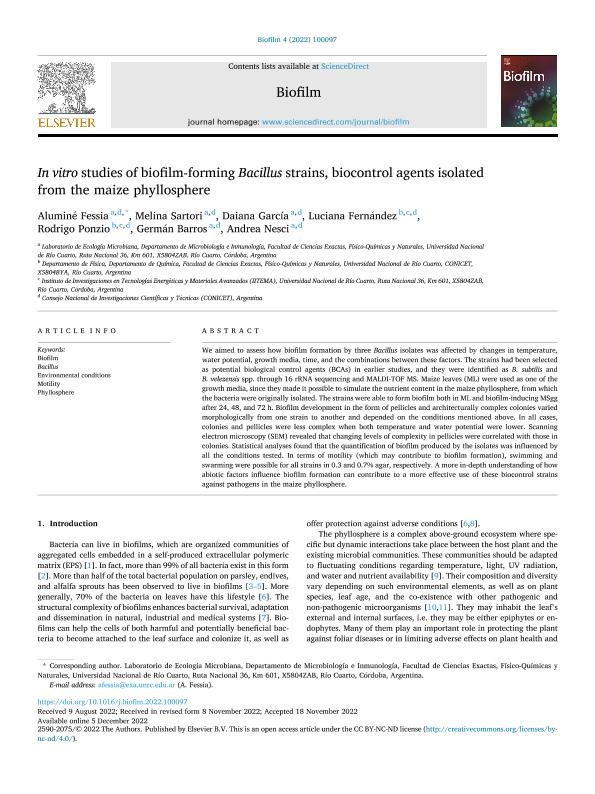Mostrar el registro sencillo del ítem
dc.contributor.author
Fessia, Alumine Soledad

dc.contributor.author
Sartori, Melina Victoria

dc.contributor.author
García, Daiana

dc.contributor.author
Fernandez, Luciana Andrea

dc.contributor.author
Ponzio, Rodrigo Andrés

dc.contributor.author
Barros, Germán Gustavo

dc.contributor.author
Nesci, Andrea Verónica

dc.date.available
2024-01-10T13:43:15Z
dc.date.issued
2022-11
dc.identifier.citation
Fessia, Alumine Soledad; Sartori, Melina Victoria; García, Daiana; Fernandez, Luciana Andrea; Ponzio, Rodrigo Andrés; et al.; In vitro studies of biofilm-forming Bacillus strains, biocontrol agents isolated from the maize phyllosphere; Elsevier; Biofilm; 4; 11-2022; 1-13
dc.identifier.issn
2590-2075
dc.identifier.uri
http://hdl.handle.net/11336/223196
dc.description.abstract
We aimed to assess how biofilm formation by three Bacillus isolates was affected by changes in temperature, water potential, growth media, time, and the combinations between these factors. The strains had been selected as potential biological control agents (BCAs) in earlier studies, and they were identified as B. subtilis and B. velezensis spp. through 16 rRNA sequencing and MALDI-TOF MS. Maize leaves (ML) were used as one of the growth media, since they made it possible to simulate the nutrient content in the maize phyllosphere, from which the bacteria were originally isolated. The strains were able to form biofilm both in ML and biofilm-inducing MSgg after 24, 48, and 72 h. Biofilm development in the form of pellicles and architecturally complex colonies varied morphologically from one strain to another and depended on the conditions mentioned above. In all cases, colonies and pellicles were less complex when both temperature and water potential were lower. Scanning electron microscopy (SEM) revealed that changing levels of complexity in pellicles were correlated with those in colonies. Statistical analyses found that the quantification of biofilm produced by the isolates was influenced by all the conditions tested. In terms of motility (which may contribute to biofilm formation), swimming and swarming were possible for all strains in 0.3 and 0.7% agar, respectively. A more in-depth understanding of how abiotic factors influence biofilm formation can contribute to a more effective use of these biocontrol strains against pathogens in the maize phyllosphere.
dc.format
application/pdf
dc.language.iso
eng
dc.publisher
Elsevier

dc.rights
info:eu-repo/semantics/openAccess
dc.rights.uri
https://creativecommons.org/licenses/by-nc-nd/2.5/ar/
dc.subject
BACILLUS
dc.subject
BIOFILM
dc.subject
ENVIRONMENTAL CONDITIONS
dc.subject
MOTILITY
dc.subject
PHYLLOSPHERE
dc.subject.classification
Biología Celular, Microbiología

dc.subject.classification
Ciencias Biológicas

dc.subject.classification
CIENCIAS NATURALES Y EXACTAS

dc.title
In vitro studies of biofilm-forming Bacillus strains, biocontrol agents isolated from the maize phyllosphere
dc.type
info:eu-repo/semantics/article
dc.type
info:ar-repo/semantics/artículo
dc.type
info:eu-repo/semantics/publishedVersion
dc.date.updated
2024-01-10T12:09:18Z
dc.journal.volume
4
dc.journal.pagination
1-13
dc.journal.pais
Reino Unido

dc.description.fil
Fil: Fessia, Alumine Soledad. Universidad Nacional de Río Cuarto. Facultad de Ciencias Exactas, Fisicoquímicas y Naturales. Departamento de Microbiología e Inmunología; Argentina. Consejo Nacional de Investigaciones Científicas y Técnicas. Centro Científico Tecnológico Conicet - Córdoba; Argentina
dc.description.fil
Fil: Sartori, Melina Victoria. Universidad Nacional de Río Cuarto. Facultad de Ciencias Exactas, Fisicoquímicas y Naturales. Departamento de Microbiología e Inmunología; Argentina. Consejo Nacional de Investigaciones Científicas y Técnicas. Centro Científico Tecnológico Conicet - Córdoba; Argentina
dc.description.fil
Fil: García, Daiana. Universidad Nacional de Rio Cuarto. Facultad de Cs.exactas Fisicoquímicas y Naturales. Departamento de Física; Argentina. Consejo Nacional de Investigaciones Científicas y Técnicas. Centro Científico Tecnológico Conicet - Córdoba; Argentina
dc.description.fil
Fil: Fernandez, Luciana Andrea. Universidad Nacional de Río Cuarto. Facultad de Ciencias Exactas Fisicoquímicas y Naturales; Argentina. Universidad Nacional de Río Cuarto. Facultad de Ciencias Exactas Fisicoquímicas y Naturales. Instituto de Investigaciones en Tecnologías Energéticas y Materiales Avanzados. - Consejo Nacional de Investigaciones Científicas y Técnicas. Centro Científico Tecnológico Conicet - Córdoba. Instituto de Investigaciones en Tecnologías Energéticas y Materiales Avanzados; Argentina
dc.description.fil
Fil: Ponzio, Rodrigo Andrés. Universidad Nacional de Río Cuarto. Facultad de Ciencias Exactas Fisicoquímicas y Naturales. Instituto de Investigaciones en Tecnologías Energéticas y Materiales Avanzados. - Consejo Nacional de Investigaciones Científicas y Técnicas. Centro Científico Tecnológico Conicet - Córdoba. Instituto de Investigaciones en Tecnologías Energéticas y Materiales Avanzados; Argentina. Universidad Nacional de Rio Cuarto. Facultad de Cs.exactas Fisicoquímicas y Naturales. Departamento de Física; Argentina
dc.description.fil
Fil: Barros, Germán Gustavo. Universidad Nacional de Río Cuarto. Facultad de Ciencias Exactas, Fisicoquímicas y Naturales. Departamento de Microbiología e Inmunología; Argentina. Consejo Nacional de Investigaciones Científicas y Técnicas. Centro Científico Tecnológico Conicet - Córdoba; Argentina
dc.description.fil
Fil: Nesci, Andrea Verónica. Universidad Nacional de Río Cuarto. Facultad de Ciencias Exactas, Fisicoquímicas y Naturales. Departamento de Microbiología e Inmunología; Argentina. Consejo Nacional de Investigaciones Científicas y Técnicas. Centro Científico Tecnológico Conicet - Córdoba; Argentina
dc.journal.title
Biofilm
dc.relation.alternativeid
info:eu-repo/semantics/altIdentifier/url/https://www.sciencedirect.com/science/article/pii/S2590207522000314?via%3Dihub
dc.relation.alternativeid
info:eu-repo/semantics/altIdentifier/doi/https://doi.org/10.1016/j.bioflm.2022.100097
Archivos asociados
